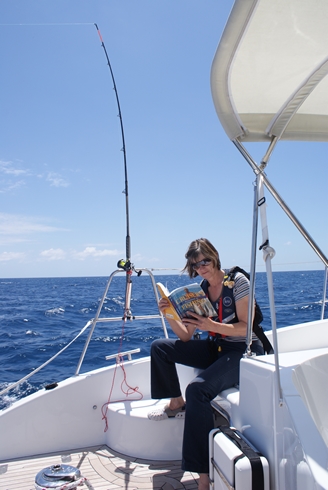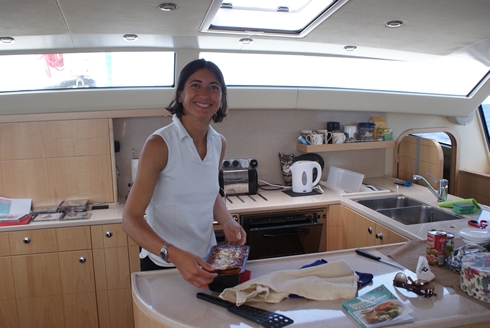21:22.79N 064:40.47W
Charles Dickens, describing his journey to
America, is at the same time alarmed
and amazed by the effect of headwind in its strength, the way it pitches the
boat about and the noise that is generated within the ship. He recounts: “Imagine a human face upon
the vessel’s prow, with fifteen thousand Samsons in one bent upon driving her
back, and hitting her exactly between the eyes whenever she attempts to advance
an inch. Imagine the ship herself,
with every pulse and artery of her huge body swoln and bursting under this
mal-treatment, sworn to go on or die.
Imagine the wind howling, the sea roaring, the rain beating: all in
furious array against her. Picture the sky both dark and wild, and the clouds,
in fearful sympathy with the waves, making another ocean in the air… and there
is the head wind of that January morning.”
Of course, a modern yacht is nothing like a heavy ship of
the mid 1800s, but headwinds are an effort whatever boat you are on. The boat is slowed by the constant force
against it. Invariably it isn’t able to sail directly to where is should be
going, which is demoralising and the motion that the sea generates can quickly
tire the crew. Certainly, I found
the two days we had strong headwinds quite a struggle. Also, two days away from Bermuda the
sheave in the mainsail clew blew apart, and despite a jury rig, we felt we
didn’t want to put too much load on it, so had just a tiny main heading to
windward, making for a slower and harder passage. At other times all was fine:
Desiree and I rather enjoyed the deluge of torrential rain and having to negotiate
the shifting, gusting winds as we sailed through a cold front, and playing
Rossini overtures at full volume whilst drinking good red wine and romping along
on a broad reach has to be the way to sail. Lying in the hot-tub as the water gently
swished from side to side wasn’t bad either.
What is surprising, whatever the passage (we had done
about 2050 miles since the Azores), is just how
quickly it all gets put behind you when you reach your destination. We arrived off St George’s just before
dawn on 2nd June. What
strikes you right from the start is the civility of Bermudians: from the person
on the Harbour Radio calling up to ask if we wouldn’t mind waiting until 8am to
make our final approach as there was a cruise ship coming in just before us; to
the fact that everyone – whether painting a house, in a bus queue, or sat on a
bench in the street –will greet you with a cheery ‘good morning’ or ‘good
afternoon’. If you looked lost you are asked if you need help; children are made
to wait until adults have first boarded the bus and the most popular woman’s
magazine in the supermarket seemed to be The Ladies Home Journal –
Brilliant!
Bermuda is
very proud of its history from when it was first settled after the Sea Venture ran aground in 1609; its
Georgian trading prosperity and British naval dockyards. But it has also retained its almost
pathological dislike for rats, since the time when the islands were so overrun
with them that the inhabitants were starving. When completing the Declaration of
Health form as you arrive, the second question reads: “Has plague occurred or
been suspected amongst the rats or mice on board during the voyage, or has there
been an unusual mortality amongst them. (If more than six weeks have elapsed
since the voyage began, it will suffice to give particulars of the last six
weeks.)”
The thing that hits you with force as soon as you set
eyes on Bermuda is colour! Not just turquoise water within the
reef, made all the more perfect by the backdrop of white puffy clouds and great
clarity of light, but the buildings. The buildings are like a bag of liquorice
allsorts or dolly mixture sweets that have split open over the hillside. Walls
are just bold, bright colours, contrasted by different hues on the shutters
which shade the deep windows. Blue, yellow, pink, lime green, maroon, mauve –
and some subtler colours – mesmerize you. Each building has a stepped, limestone
roof that is painted white and from a distance it is almost as though there has
been a snow fall – it is quite bizarre, but great.
For us, stepping ashore in the main square of St George’s was rather surreal. The town
hall is flanked by traditional Georgian buildings and there is a replica of Deliverance, which was built in 1609.
You feel you have stepped back in time.
Yet the illusion is shattered by the day-trippers that have come from the
cruise liners. Oh how a cartoonist
would revel in the caricatures they could create!
Whilst Desiree was still with us, we packed in a lot of
exploring – by dinghy, bus and on foot.
The many beaches are fantastic, with their pinky-gold sand flanked by
ragged shaped dark rocks. On one
beach I swam out to explore the rocks and touched an amazing fish: about 20
inches long, the body of a carp, huge scales and bright green with a long red
tail. I also saw the vibrant turquoise of a parrot fish and snorkelling gave
more delight.
By co-incidence another Discovery - Festina Lente - sailed in to the bay and
it was great to be able to spend an evening with the crew: Nick, who we know
well, John and Leslie, whose Discovery 55 will be delivered in 2012 and Steve
who will be doing a second circumnavigation when he’s found the right
second-hand boat. Nick has sailed
Festina Lente one and a half times
round the world and is now on his way to Europe.
Today we have chilled out and did some
things which, although mundane, are definitely different from when you are
living in a house. With some trepidation John cut my hair. It’s the first time I have used a
hand-bearing compass to locate the supermarket, which we reached by dinghy and,
rather than washing the car, I swam round the boat with hull cleaner and sponge
in hand so that I could give the waterline a spruce-up. I also made bread for the first time in
years - who would have thought that I might miss Tesco’s?







